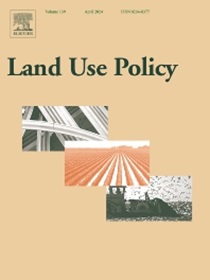Applying Zipf’s law to land-use classes in a tourism-specialized metropolitan context
IF 6
1区 社会学
Q1 ENVIRONMENTAL STUDIES
引用次数: 0
Abstract
The present study examines metropolitan growth dynamics employing Zipf's law to investigate, likely for the first time in literature, the spatial organization of landscape across the urban-rural hierarchy based on a vast and diversified ensemble of land-use classes. Using high-resolution data from Copernicus Urban Atlas initiative, the approach evaluates the actual rank-size distribution of 20 distinct land-use categories within metropolitan Athens, Greece. As a novel contribution to regional science, three model specifications were tested on the individual land parcel: (i) a baseline model verifying the rank-size relationship for each land-use class, (ii) an extended model incorporating a fractal index to capture landscape complexity, and (iii) a model adding the distance from downtown Athens to verify the mono-centric assumption à la Von Thünen. Empirical findings reveal significant variations in Zipf’s applicability across different land-use classes, highlighting the influence of spatial convolution and metropolitan gradient on the rank-size distribution. The spatially explicit Multi-scale Geographically Weighted Regression (MGWR) method outperforms the Ordinary Least Squares (OLS) approach, confirming the appropriateness of accounting for both spatial distribution and local heterogeneity of land parcels when testing the rank-size relationship. Results indicate that, while certain land-use classes exhibit patterns closely aligned with Zipf's law, others demonstrate deviations that reflect varying levels of spatial regularity, underlying economic and/or natural constraints. The study underscores the importance of land-use specificity in spatial planning and suggests policy interventions aimed at sustainable land management when planning the long-term evolution of metropolitan hierarchies. These insights contribute to refining regional development strategies, promoting balanced growth, and preserving land resources in metropolitan areas.
将齐夫定律应用于以旅游为主的大都市背景下的土地使用类别
本研究利用齐夫定律考察了大都市的增长动态,这可能是文献中第一次基于大量和多样化的土地利用类别,调查城乡等级之间景观的空间组织。利用哥白尼城市地图集计划的高分辨率数据,该方法评估了希腊雅典大都市内20种不同土地利用类别的实际等级大小分布。作为对区域科学的新贡献,在单个地块上测试了三种模型规范:(i)验证每个土地利用类别的等级-规模关系的基线模型,(ii)包含分形指数的扩展模型以捕获景观复杂性,以及(iii)添加雅典市中心距离的模型以验证单中心假设(la Von thenen)。实证结果表明,Zipf在不同土地利用类别中的适用性存在显著差异,突出了空间卷积和大都市梯度对等级-规模分布的影响。空间显式多尺度地理加权回归(MGWR)方法优于普通最小二乘(OLS)方法,证实了在检验等级-规模关系时考虑地块空间分布和局部异质性的适宜性。结果表明,虽然某些土地利用类别表现出与Zipf定律密切相关的模式,但其他土地利用类别表现出反映不同程度的空间规律性、潜在的经济和/或自然约束的偏差。该研究强调了土地使用特殊性在空间规划中的重要性,并建议在规划都市等级的长期演变时采取旨在可持续土地管理的政策干预措施。这些见解有助于完善区域发展战略,促进平衡增长,保护大都市地区的土地资源。
本文章由计算机程序翻译,如有差异,请以英文原文为准。
求助全文
约1分钟内获得全文
求助全文
来源期刊

Land Use Policy
ENVIRONMENTAL STUDIES-
CiteScore
13.70
自引率
8.50%
发文量
553
期刊介绍:
Land Use Policy is an international and interdisciplinary journal concerned with the social, economic, political, legal, physical and planning aspects of urban and rural land use.
Land Use Policy examines issues in geography, agriculture, forestry, irrigation, environmental conservation, housing, urban development and transport in both developed and developing countries through major refereed articles and shorter viewpoint pieces.
 求助内容:
求助内容: 应助结果提醒方式:
应助结果提醒方式:


